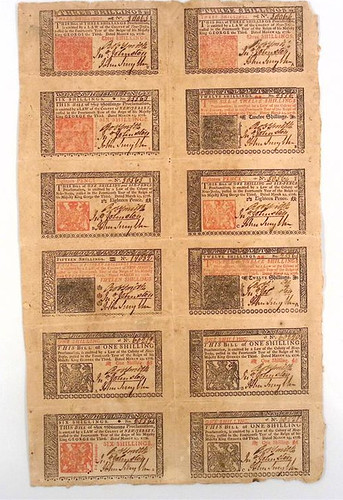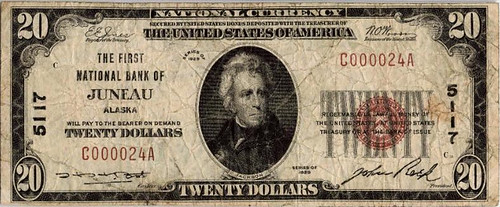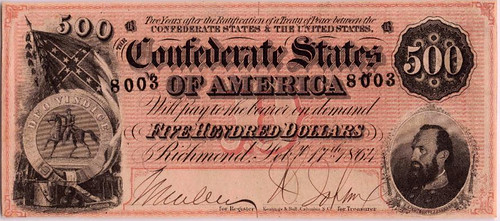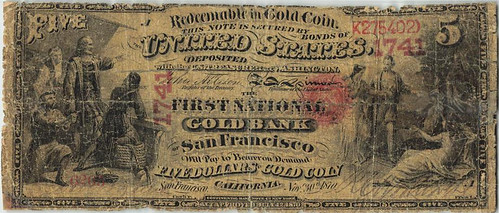
PREV ARTICLE
NEXT ARTICLE
FULL ISSUE
PREV FULL ISSUE
WBNA US CURRENCY SALE FIVE HIGHLIGHTSThe World Banknote Auctions U.S. Currency Sale 5 bidding begins February 9, 2024 at 10 AM PST. Consignment Director Ryan Baum sent along these highlights and comments. -Editor Ryan writes: "Colonial Currency has become popular again as we look ahead to our nation's 250th birthday in a couple of years. Although we have handled several Colonials, we have an unusual uncut New Jersey sheet of mixed denominations. This is not a remainder as all notes are signed and serial-numbered. We tried to figure out the logic behind the denominations and how it aggregates to a total value of 3 Pounds, 3 Schillings. Could the extra Schillings represent a 5% fee to the printer when cut?" New Jersey March 25, 1776 Fr. NJ-175-180 PMG Extremely Fine 40 1/- to 15/- Shillings (Uncut Sheet) Extremely Rare and Historic Uncut Sheet of 12 from New Jersey Issue of March, 1776.
This sheet includes the six initial denominations of the March 25, 1776 issue. The latest issue of Eric P. Newman's The Early Paper Money of America highlights the complicated background of this issue. The issuance of these notes traced its authorization back to 1768, when £ 100,000 in bills of credit were to be issued subject to the Crown's consent, along with an additional £ 25,000 to replace worn out bills of previous issues. The Crown never moved to authorize the issuance and according to Newman; it wasn't until after the American Revolution began that these Bills of Credit were issued for circulation and made Legal Tender according to the Act of September 20, 1776. Even though single notes of this issue are relatively common in all grades, an uncut sheet (or fraction thereof) is a different story. Uncut Colonial Sheets from New Jersey are seen much more infrequently than those from, for example, Pennsylvania and Rhode Island. Ford had just three uncut sheets from New Jersey, all of which were part of the F.C.C. Boyd estate. Seeing this uncut sheet brings up a couple of questions regarding printing and numbering. For example, the serial numbers follow no logical pattern, and there are an uneven number of notes spread out over the six denominations: 3x 1 Shilling, 2x 18 Pence, 2x 3 Shillings, 2x 6 Shillings, 2x 12 Shillings and 1x 15 Shillings. This is a different sheet layout than the pane in the Ford collection, which featured a 30 Shillings note instead of an additional 6 Shillings. Each note carries three handsigned signatures: Robert Smith, Jonathan Johnston and Joseph Smith. An exceptional item worthy of the finest collection of Colonial Paper Money. PMG mentions "Splits; previously mounted".
To read the complete lot description, see:
Ryan writes: "Among Nationals we were fortunate to receive an elusive Alaska note. While many collectors view Nevada as a difficult state, Alaska is even rarer. Interestingly this note also has a connection to California given the founders were from Santa Barabara and decided to follow the Klondike Rush to Alaska. A two digit serial number is an added treat to this note." Juneau, AK 1929 Ty. Fr. 1802-1 The First NB CH# 5117 PMG Choice Fine 15 20 Dollars For a serious collector of national banknotes, here is a note from the rarest of the 50 states, Alaska, and from its State Capital as well. Only three national banks were chartered in Alaska before 1935 with this bank being the first. The First National Bank of Juneau chartered in 1898 during the peak of the Kondike Gold Rush. The initial founders rushed to Alaska from Santa Barbara, CA, where they had already engaged in banking. They founded the bank with $50,000 in capital of which $12,500 was used to purchase bonds to secure banknote circulation. Only in 1932 did the bank raise its circulation to $50,000 shortly before the end of the note issuing period, a still surprisingly small number for a bank whose assets were nearly $1.5 million. The First National Bank of Juneau issued only 8,099 in small size notes of which only 14 notes are known in the current census with this new note raising the census to 15, still far too few to satisfy the consistent demand for notes from the Last Frontier. Although the note certainly shows circulation usage, it is a pleasing Choice Fine grade and low two digit serial number. With notes from this bank only appearing at auction less than every other year, now is a rare opportunity for a collector who truly aspires to collect all fifty states. PMG mentions "Minor repair".
To read the complete lot description, see:
Ryan writes: "Moving to warmer climates, we have a beautiful proof of a Republic of Hawaii $100 Silver Certificate. Unlike the earlier issue during the monarchy, this was intended to be issued by the brief independent republic but was annexed by the United States before the notes could be issued." Hawaii 1895 P-15pp1 PMG Superb Gem UNC 67 EPQ 100 Dollars (Front Proprietary Proof) A proof for a note that could have been but never was. While many collectors are familiar with Hawaii's issued coins, few are aware of its paper money history. This proof is of what was to have been a $100 Silver Certificate printed by American Banknote Compnay and issued during the brief Republic of Hawaii, a four year period from 1894 following the deposing of the last Hawaiian Monarch to 1898 when annexed by the United States. The primary design of this note was based on the same vignettes and layout of the 1879 $100 Silver Certificate series during the time of the Monarchy. The text and designs in the 1895 design are streamlined with more straight-line and linear layout than the earlier curved text and designs. As a tribute to Hawaii's local and global position in trade, the horse and cattle represent agriculture while the globe displays major shipping lanes converging in what is now Panama. This proof makes a significant addition to any collector looking to move beyond typical American type notes and is a true crossover of U.S. and World Currency.
To read the complete lot description, see:
Ryan writes: "Another note I enjoyed working with was a $500 Confederate States note with vivid colors unlike the later issues of the same note. This note is a CSA type-note of its own with the Stars and Bars battle flag." Confederate States 1864 T-64 PCGS Choice About UNC 55 PPQ 500 Dollars A fully original example of this popular Confederate $500 issue with particular strong color for the type. As the American Civil War raged on the South had increasingly difficulty acquiring inks, including the pink/red needed for its banknotes. As a result, later printings of this issue tend to be very faded with little color, which is how this type is typically seen. Any example with strong color, such as this one, is much scarcer and worth a premium bid.
To read the complete lot description, see:
Ryan writes: "Another interesting note is a National Gold Banknote in well circulated condition. This note's condition demonstrates how these notes were preferred in California for several decades despite the greenback getting back to par by the end of the 1870s. This note is also on the first national bank to charter in California with an 1870 date and is perfect for someone expanding into gold banknotes." San Francisco, CA 1870 Fr. 1136 First National Gold Bank CH# 1741 PMG Good 4 NET 5 Dollars National Gold Banknotes were the workhorses of California's economy in the 1870's. Here's a survivor that illustrates that quite well, as this 5 Dollar from the First National Gold Bank of San Francisco shows. Despite having spent considerable time in circulation, most of the design elements remain clear, and the overall eye-appeal is better than the technical grade would suggest. The pen signatures remain visible and the color of the note is strong. Overall a pleasing yet what should be an affordable example of one of the most iconic and popular issues of United States currency. PMG mentions "Tape; internal splits"
To read the complete lot description, see:
See an article elsewhere in this issue for more on the National Gold Banks. -Editor
Wayne Homren, Editor The Numismatic Bibliomania Society is a non-profit organization promoting numismatic literature. See our web site at coinbooks.org. To submit items for publication in The E-Sylum, write to the Editor at this address: whomren@gmail.com To subscribe go to: https://my.binhost.com/lists/listinfo/esylum All Rights Reserved. NBS Home Page Contact the NBS webmaster 
|





